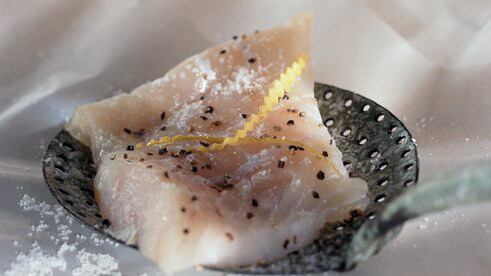
Baccalà alla Trevigiana (Baccalà Treviso-Style) Yield: serves 6 or more.
I must say, I am particularly partial to the whipped dry cod, which my father, Vittorio, now long gone, would whip for hours with a mallet until it became a cream on the day of Christmas Eve. Christmas would not be Christmas without Baccalà Manteccato at our house. Today salted cod—baccalà—is available in many supermarkets and your fish monger should carry it. It comes in boneless sides and it is best to get center cuts, which are meatier and less salty. In any case, thorough soaking, as detailed in the recipe, is vital to the success of the dish. In Treviso, baccalà Trevisano is always served with baked polenta and the combination of flavors and textures is so delicious I never break tradition. Make the polenta the day before you cook the baccalà and you can finish both in the oven at the same time.
2 lbs. boneless baccalà (salt cod) 1 cup or more flour, for dredging 4 tablespoons butter 4 tablespoons extra-virgin olive oil 2 medium onions (1 pound), peeled, halved and sliced ¼-inch thick 1 quart milk (or more if needed) 1 cup Parmigiano-Reggiano or Grana Padano or more as needed Baked polenta, (finish and serve with baccalà per instructions)
Recommended equipment: A heavy-bottomed sauce pan or high-sided sauté pan, 10- to 12-inches diameter, with a cover. And a baking dish or shallow casserole, 9- by 13-inches or similar size
To remove the salt from the salt cod, put it in a large deep container that fits in your sink, under the faucet. Run fresh cold water over the fish, filling the container completely so water is spilling over the brim. Keep a slow steady drip of fresh water going as you soak the baccalà for at least 12 hours, up to a couple of days. Occasionally drain the water and refresh (which you can do whenever you need the sink). If you can’t keep the drip going, change the water every 4 hours. To decide when baccalà has been soaked sufficiently, lift the fish out of the water, press a finger against it at a thick part, and touch it to the tongue. If it’s palatably salty, it is ready to be cooked. Drain the baccalà, pat dry, and cook within a day or so. Store it in the refrigerator, well wrapped.
Cut the baccalà into chunks, about 3-inches square and dredge on all sides in flour. Put the butter and olive oil in the saucepan and set over medium heat. When the butter is foaming, lay in a batch of floured codfish chunks in one layer, not crowded. Cook and color the underside for several minutes, turn the chunks and crisp and color the other sides. When lightly browned all over, remove the to a platter. Fry the remaining chunks the same way.
Dump the onion slices into the pan and toss well in the remaining oil. As the onions start to sizzle and wilt, pour in ½ cup water and stir and scrape up the browned bits on the pan bottom. Cook the onions, stirring frequently, until wilted and translucent, 8-10 minutes. Meanwhile, heat the milk almost to a simmer.
Lay the baccalà chunks on top of the caramelized onions, nestling in all the chunks in one layer. Pour in any juices from the fish platter and enough hot milk to completely cover the fish. Over medium heat, bring the milk to a gentle bubbling simmer. Set the cover slightly ajar and simmer the baccalà for about an hour and a half, until the fish chunks break apart when stirred.
Uncover the pan and maintain the slow simmer to gradually reduce the milk (which by now has curdled and separated—no cause for concern). Stir the fish occasionally and break up the flakes into smaller pieces. As the moisture evaporates, lower the heat and scrape up any crust on the pan bottom, to avoid burning.
Cook uncovered slowly for 2 to 2-1/2 hours, until the baccalà and milk have melded into a thick sauce, about half the original volume. (If you need to shorten the cooking time, boil the milk over higher heat but be sure to stir the baccalà and scrape the saucepan frequently.)
When fully cooked and thickened in the saucepan, pour the hot baccalà into the baking dish and spread it in an even layer. Heat the oven to 350° and set a rack in the center. Sprinkle grated Parmigiano-Reggiano or Grana Padano over the top of the baccalà and bake for about an hour or until the top is crusty and browned.
Bake slices of firm polenta, topped with grated cheese, during the last 15 or 20 minutes that the baccalà is in the oven. To serve, put a slice or more of crisp polenta in a plate and spoon some hot baccalà alongside.
From Lidia’s Italy, Knopf 2007.
Scampi Alla Buonavia Yield: Serves 6
This appetizer was very popular at my first restaurant, Buonavia, which opened in 1971. It was a time when lots and lots of chopped garlic was used in Italian-American cooking. If you like a milder garlic flavor, use crushed or sliced garlic cloves instead, and remove them from the dish before you serve it.
3 tablespoons extra virgin olive oil, plus more for finishing dish 3 garlic cloves, chopped fine 1 pound extra-large (about 25 to the pound) shrimp, completely shelled, deveined and cut crosswise into 3 pieces 1 tablespoon chopped chives ½ cup dry white wine 4 tablespoons unsalted butter, cut into 4 pieces 1 tablespoon lemon juice 1 tablespoon chopped Italian parsley ½ teaspoon crushed red pepper Salt 6 slices Italian bread (about 1/4-inch thick and 2 1/2 inches wide), toasted and kept warm 1 lemon, cut into slices Whole chives and/or parsley sprigs, optional
In this dish, high heat and speed heat are essential. Make sure the pan is good and hot when you add the shrimp and that it is wide enough to hold all the shrimp pieces in a single layer (so it doesn’t cool down as they go in). And be sure to have all your ingredients right by the stove—once the shrimp go into the pan, it’s full speed ahead.
Heat 3 tablespoons olive oil in a large skillet, over medium heat. Add the garlic and cook, shaking the pan, until light golden, about 2 minutes. Raise the heat to high, add the shrimp and toss until they are bright pink and seared on all sides, about 2 minutes. Stir in the chives, then add the wine, butter and lemon juice. Bring to a boil and boil until the shrimp are barely opaque in the center and the sauce is reduced by half, about 2 minutes. Stir in the parsley.
Place a piece of warm toast in the center of each of six warm plates. Spoon the shrimp and sauce over the toast, drizzling some of the sauce around the toast. Decorate the plates with lemon, and the parsley sprigs and/or chives, if using.
From Lidia’s Italian-American Kitchen, Alfred A. Knopf 2003.
Fillet of Grouper in the Matalotta Style (Pesce alla Matalotta) Yield: 6 servings
Serve with grilled bread, or couscous or panelle. You can make this ahead of time and reheat to serve—just take the pot off the heat a bit before the fish and sauce are thoroughly cooked. In Sicily, the most popular fish to cook alla Matalotta is whatever was just caught fresh! The aromatics and technique remain the same and the outcome is always delicious. My top fish recommendation for this recipe is grouper; it has flesh that cooks and keeps together in the sauce. Halibut, striped bass, and black bass are other good choices. A whole black bass cooked alla matalotta is delicious—just mind the bones.
2 lbs. skinless grouper fillet 1 teaspoon coarse sea salt or kosher salt or to taste 1/2 cup extra-virgin olive oil plus more for finishing Flour for dredging, ½ cup or so 1 onion thinly sliced (1 cup) 4 garlic cloves crushed and peeled ½ cup finely chopped celery heart and leaves 1 cup Sicilian or other large green brine-cured olives, pitted and cut in half 2 tablespoons small capers, drained ½ teaspoon peperoncino or to taste 2 cups canned Italian plum tomatoes, preferably San Marzano, crushed by hand 3 cups hot water or as needed 6 large fresh basil leaves shredded 3 tablespoon chopped fresh Italian parsley
Recommended equipment: A heavy-bottomed saucepan or sauté pan, 13 inches or wider, with a cover
Slice the grouper fillet into 6 chunks, roughly equal in size, and season with ¼ teaspoon of the salt.
Pour the ½ cup olive oil into the big saucepan and set it over medium-high heat. Dredge the fish chunks in flour, shake off any excess and lay them in the hot oil. Cook for about 1-1/2 minutes until opaque on the underside; turn the pieces and lightly color the second side. Remove the grouper chunks with a spatula to a platter.
Scatter the onion slices in the pan, stir and scrape any bits left in the pan. Toss in the garlic cloves, the chopped celery, stir well and season with the peperoncino and another ¼ teaspoon salt. Stir for a couple of minutes as the vegetables sizzle, strew olives and capers in the pan and stir until they’re sizzling too.
Pour in the crushed tomatoes and 3 cups of hot water. Turn up the heat and stir up all the vegetables as the liquid comes to a boil. Adjust the heat to keep it bubbling, stir in the shredded and ½ teaspoon salt and partially cover the pan.
Simmer the sauce for 10 minutes or so, then lay the grouper chunks in the pan in one layer, and pour in any fish juices that accumulated in the platter. The chunks should be nearly covered by the sauce; add more hot water if necessary. Heat rapidly back to the boil, then simmer gently, partially covered. Shake the pan occasionally to distribute the sauce and slosh it over the fish.
When the grouper is tender and the sauce is slightly thickened and flavorful, 20 to 25 minutes, and turn off the heat. Taste and adjust the seasoning. Just before serving, drizzle over a tablespoon or two of olive oil and sprinkle the parsley all over the top.
Recipe courtesy Lidia Bastianich.






